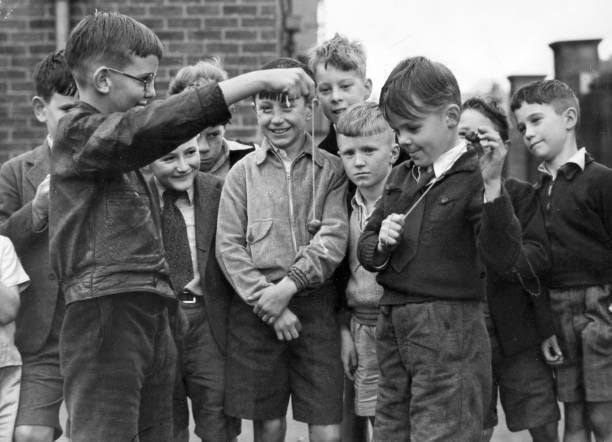What Games Did You Play?
The kids will figure out what to play
I rode through my old neighborhood in Providence last week, intending to reconnect with the familiar spots from our play days. It was fun, nostalgic, and at times, a bit sad.
In one well-mapped square mile lay a boundless kingdom, extending from park to park, street to street, under the streetlight, in the church schoolyard, and occasionally at the school gym.
It was our secret civilization where baseballs, footballs, and basketballs had a purpose and were appreciated in the confines of that world. Gods populated golden fields. Who were the gods, you might ask? Well.
As I drove, I conjured images of the games. I saw kids spill out of their homes and onto streets that served as playgrounds for the usual and not-so-usual games.
We played football and baseball in a lot that seemed huge. I thought my home runs were immense, and my touchdowns were Jim Brown worthy.
The corner streetlight was the constant through all seasons, a base for street baseball, where the netless basket hung for basketball, a goal for hide and seek, and a snowball target as we practiced pitching.
The cement steps leading to the front porch were the perfect spot for the game of “Outs.” The rules were the same, but there were no bats, bases, or white lines—only two players: one who threw the ball against the steps and the fielder. Any catch was an out, a miss an error, a passing grounder a single; on the fly was a double.
A ball hit on the angle of a step rebounded and shot, screaming over the fielder’s head for the rare homer. We used a tennis ball because the pink Spaldeen was too lively, too many home runs, and too hard to catch. The Spaldeen was best for fistball, high pop-ups, big bouncers and stickball when cut in half.
Stickball was a game best played in the schoolyard with the strike zone outlined in white chalk on the school’s brick. The stick was honed to a thin handle and thick end, and was hidden after the game. If only one or two players were on the side, then the half ball was best; less running, no lost balls, lots of curves.
We shot rats and Spam cans in the dump with our slingshots, using stones for missiles. We had messy, spittle-laden bean blower fights.
In the sandbanks adjacent to the dump, we played games of Cowboys, Army, and capture-the-flag.
In almost any place, we played chestnuts, marbles, hide and seek, and jackknife.
Sandlot baseball was the best. We, not adults, organized the games. We fantasized that we were major league players, announcing their spot in the batting order, their stats, and emulating their stances.
“I have brand new balls,” said Walter, the blond, goofy, string bean left-hander who fooled us often. “I just taped them.”
I got lots of advice about what to do with my new baseball glove.
“Make sure you grease that glove well. It will last a lifetime. Yogi used to dip a new mitt in water, and then pound it with a bat to break it in.”
“Vaseline it, put a ball in it, and then wrap it with string. Leave it overnight.”
Fistball was a baseball variant that we played in the George J. West Junior High School yard during recess.
We shared an arsenal of games: Red Rover, Simon Says, dodge ball, tag, hopscotch, jump rope, bats, pickle, standers (a card game), pitching pennies, and throwing planes made of popsicle sticks. We had sleds and hockey sticks.
Well, here’s 1,2,3, Redlight by the 1910 Fruitgum Company
We made a parachute with a handkerchief, a sinker, and some string, tying the four corners of the handkerchief to the string, and the string to a lead sinker and an Army toy soldier. We twirled the parachute and launched it. The highest throw with a parachute that opened won. The trees and wires of our neighborhood were loaded with hanging parachutes.
It was a rare day when I walked out of the house to empty fields and streets. It was a rare day when there were no games.
I went out the back door, down the driveway along grandfather’s garden, took a quick left to the sidewalk, then across the front of the garden for a few more steps, another quick left, and I was on golden fields, the streets where friends and foes lived; where the action was.
What remains of those places? What do we learn when we return?
We grow. We learn that we will never set foot there again, save for that nostalgic drive by. We marvel at a space so small. No matter. It was our kingdom, our kingdom.
We will never be in a game with those gladiators in that kingdom again, but we remember. We remember the home runs, the winning shot from the sewer cover, and the kids. Oh yes, the kids.
In his book, Children at Play: An American History, Professor Howard P. Chudacoff ends with a message. “In a society obsessed with risk and
giving children a head start, adults need to offer kids more independence to explore their environment, to create their own playthings, and
to enjoy being young.”
We kids figured it out. We return to our spaces. Our spaces where there are past wonders of games and golden fields.
Copyright 2025



Being a girl, my games were very different. Maybe boring. I was the queen of jacks and fiddlesticks. Very sedate games , no physicality. If we had chalk, occasionally hopscotch. Good times! Fun!
What? No wars?
When things were a bit dull, our “Street Gang” planned nighttime wars.
All I can say is that an Angel had to be watching over us and nobody was ever hurt!
Most of those games you mentioned were also ours.
Thanks Dr. Ed. for those memories!